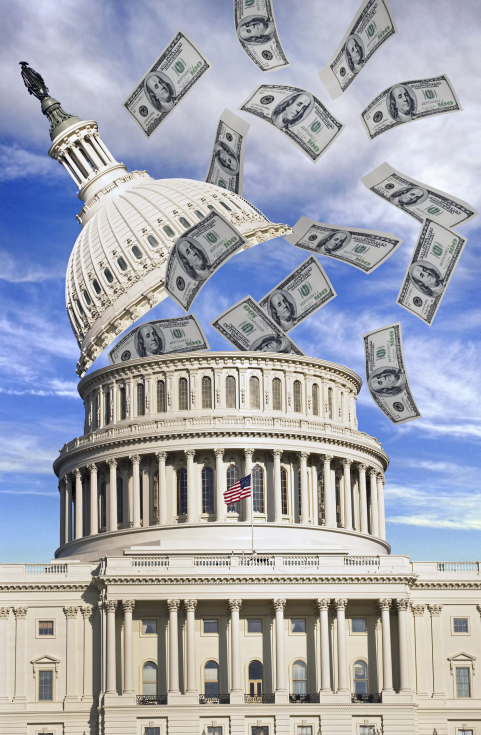Back in March 2021, as President Joe Biden signed the $1.9 trillion American Rescue Plan Act (ARPA), COVID-19 had reared its head yet again, the fiscal burdens on state and local governments seemed enormous, economic growth was sluggish, and inflation was a thing from the history books.
Since then, COVID-19 is in retreat, at least for now. State and local coffers are far stronger than anyone expected. Economic growth is robust, but inflation promises to be fierce. ARPA, which brings goodies to every state and their local governments, a strategy that once guaranteed bipartisanship, has instead fueled political battles.
Congressional Republicans stood solidly against ARPA’s passage, but that didn’t stop GOP members of Congress from claiming credit for projects in their districts funded from the $350 billion the law allocated to state, local and tribal governments. Rep. Nicole Malliotakis of New York, for example, congratulated herself for “bringing federal funding to the district and back into the pockets of taxpayers,” even though she had voted against the bill. Meanwhile, Democrats have struggled to take credit for the projects ARPA is funding.
But behind the inevitable partisan wrangling over ARPA are big questions: How is the money being spent? How much do we know? And how is that affecting the politics of the program?
Republicans are arguing that they can’t tell how the money is being used. On that, they’re right, and it’s a massive lost opportunity to use 21st-century technology to answer the fundamental questions.
There are mountains of data thanks to the law’s extensive federal reporting requirements, but the closest thing to a real-time analysis of where the money is going comes from a database assembled by the National Conference of State Legislatures (NCSL) and funded by the Pew Charitable Trusts. It makes for fascinating reading. North Dakota, for example, is spending $816,000 to catch up on maintenance at state parks and $3 million for enhancements to the International Peace Garden. In Pennsylvania, $50 million is going to higher education. Arizona is devoting $5 million to help small businesses.
These numbers, however, don’t give a clear picture of just what is happening where and when. They cover only allocations to the states; they don’t pinpoint what cities and counties are doing with their shares of the federal money. And they don’t come close to the enormously successful accountability effort launched in 2009 with the American Recovery and Reinvestment Act, an $831 billion shot in the nation’s economic arm following the Great Recession.
For the Recovery Act, a small team led by G. Edward DeSeve in then-Vice President Joe Biden’s office put together a remarkable website app, one that any user anywhere could use to locate all the projects funded near any address in the country.
For example, take a look at this screenshot of projects in the downtown Boston area in June 2011. It shows contracts, grants and loans, with each project represented by a dot. Curious users could click on each dot to get more detail about the nature of the project, who was running it and how much money was in play. It was put together in real time, so there was always instant transparency about what was happening with the Recovery Act funds.

At a big conference in Sydney, presenting to a group of government officials, I was able to use the Internet to demonstrate the data on the other side of the world, and the audience was stunned by the app. At another session with a group of high school seniors in this country, one student picked a ZIP code she was interested in, which happened to be for Seattle’s Pike Place Market. She stared at the map for about 10 seconds and then asked precisely the right question: “I wonder if they’re talking to each other?”
The app was remarkable for its sheer power. It not only provided transparency for citizens and a source for reporters, but also created a language of accountability. Government officials knew that every dollar they spent would be there for all to see, and that discouraged shenanigans. And, it’s important to remember that this was a decade ago, when data visualization was in its infancy. (For unknown reasons, the website was taken down at some point and all traces of it, except for scattered screenshots like the one above, have disappeared. It’s impossible, therefore, for you to play this game on your own.)
Far more sophisticated apps would be possible today, and they would answer the big questions about what is happening where. The Biden administration, however, has shied away from such an effort, and Republicans would rather shoot arrows than snag the data. Much of the data on the NCSL website is months old, and it contains only general descriptions like “solid waste landfills” or “water infrastructure.” As a result, it’s impossible to have an accountability conversation about the money in play, so political battles fill in the gap.
This reminds me of my days during faculty meetings when I was dean. “We can fight about it,” I said, “or we can look it up.” It’s only because of Pew’s support that we can look up what’s in the NCSL database. But the government’s data isn’t very useful for exploring governmental accountability.
As for the public players: We’ve gotten a fresh education about the word “tranche” — the ARPA funds are arriving in two chunks — but we’re getting very little insight into how the money is actually being used. Without good data to look up, that means we’re doomed to fighting about the program. And that means, in turn, that we’ve taken a big step back in accountability from where we were a decade ago, with the impact of hundreds of billions of dollars hanging in the balance.
Originally published by Governing. Republished with permission.











